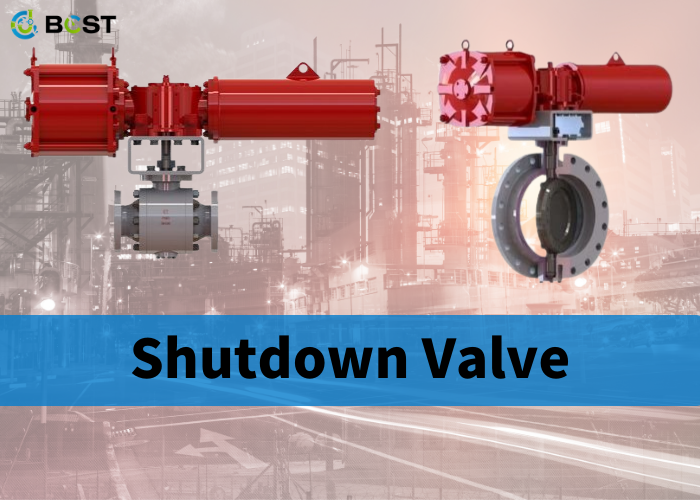
Regarding industrial safety systems, the shutdown valve (SDV) prevents accidents and safeguards equipment. With its ability to quickly halt the flow of hazardous substances, the SDV is an indispensable component in various industries. However, not all shutdown valves are created equal. This blog post will explore the twelve essential features that every high-quality SDV should possess. Whether you’re an engineer, facility manager, or interested in industrial safety, understanding these features will provide valuable insights into the critical requirements for an effective shutdown valve.
Tight Shut-off
The device must achieve zero or minimal leakage to qualify as a shutdown valve. Typically, a shutdown valve’s seat leakage must meet the requirements specified in the seat leakage testing conducted according to API 508 and ISO 5208 standards.
Fire-safe
In the event of external fire attacks, a shutdown valve must operate swiftly and effectively. Therefore, the shutdown valve body must possess a fire rating that complies with the standards such as API 607 for soft seated valves, API 6FA for API 6A and API 6D valves, or BS 6755 Part 2. This ensures the valve’s ability to withstand and function under fire conditions.
Fast Action (from fully open to fully close)
To mitigate the escalation of hazards, it is imperative for a shutdown valve to exhibit rapid Action. Typically, a quarter-ball valve is a favorable choice for quick response. As a general guideline, the shutdown valve should commence its closing action within 10 seconds of activation, while the duration from full open to full close should range between 1-2 seconds per inch of the valve size. However, ensuring these requirements align with the overall safety philosophy is crucial. Proper selection and sizing of the actuator are necessary to meet these criteria.
Minimum Passing (during the closing of the shutdown valve)
Including the minimum passing feature in a shutdown, valve is essential to reduce the risk of overpressure in low-pressure systems and prevent spurious trips. The ideal choice is a shutdown valve with equal percentage characteristics, commonly found in most ball valves (confirmation from the valve supplier is recommended). With comparable percentage characteristics, the valve can operate with a 10% closure for a 20% reduction in flow, 20% closure for a 50% reduction in flow, and so on. This allows for fast valve closure and minimizes any undesired passing of inventory.

Minimum Disturbance
Minimizing unnecessary energy loss is crucial to the shutdown valve’s design. One way to achieve this is by incorporating a reduced-bore (RB) ball valve, which features a hole in the middle to minimize flow direction changes and turbulence. Another option is a full bore (FB) ball valve, which closely resembles a pipe and significantly reduces energy loss.
Fail-safe
In terms of fail-safe operation, the shutdown valve actuator should be of the pneumatic or hydraulic fail-safe spring-return type. It is generally recommended to avoid using electrically driven actuators, as they are not suitable for ensuring the valve’s fail-safe closure (FC).
Manual Field Reset
The reset process must be performed manually in the field for a shutdown valve. The operator is responsible for verifying the system is clean and safe and performing the reset on-site. Remote reset capabilities are not permitted.
Visible Valve Position Indicators:
The shutdown valve should be equipped with external valve position indicators that are easily visible. These indicators clearly display the valve’s position and status, ensuring easy monitoring and assessment of the shutdown valve’s condition.
Position Switches
Position switches are installed on the valve to ensure precise positioning and status information of the shutdown valve in the control room. These switches provide accurate feedback on the valve’s position.
Partial Stroke Testing of Shutdown Valve:
For shutdown valves in critical services, such as pipeline outgoing and incoming shutdown valves (ESDV), periodic partial stroke testing is necessary. This testing helps maintain or enhance the valve’s reliability, availability, and safety integrity level (SIL).
Integration of Accumulators:
In some instances, shutdown valves may be equipped with accumulators. These accumulators assist in valve stroking or reopening in the event of maloperation, enhancing operational flexibility.
Second Solenoid Valve:
Critical service shutdown valves may be equipped with a second solenoid valve to enhance reliability and availability further. This redundancy feature provides an additional layer of protection and ensures continuous operation even if one solenoid valve malfunctions.
Conclusion
By considering these features during the selection and implementation of SDVs, professionals can contribute to safer and more efficient operations in their respective industries. The integration of these must-have features not only minimizes the potential for accidents and hazards and improves system performance, reliability, and longevity. Ultimately, prioritizing these essential features helps ensure the SDV’s ability to swiftly respond to emergencies, safeguard personnel, protect the environment, and maintain uninterrupted operations in critical industrial processes.






